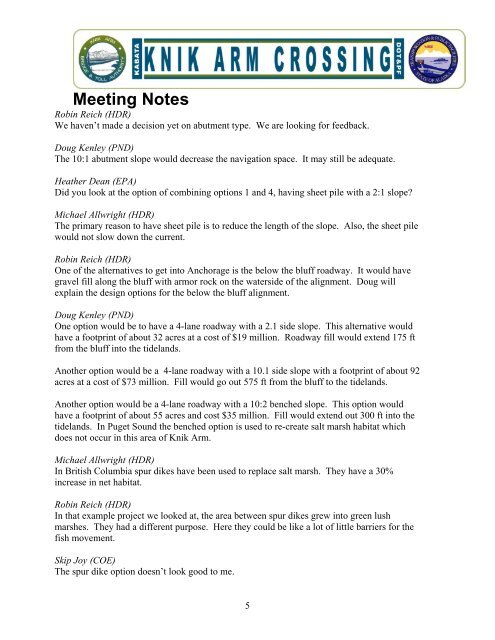Meeting Notes - Knik Arm Bridge and Toll Authority
Meeting Notes - Knik Arm Bridge and Toll Authority
Meeting Notes - Knik Arm Bridge and Toll Authority
You also want an ePaper? Increase the reach of your titles
YUMPU automatically turns print PDFs into web optimized ePapers that Google loves.
<strong>Meeting</strong> <strong>Notes</strong><br />
Robin Reich (HDR)<br />
We haven’t made a decision yet on abutment type. We are looking for feedback.<br />
Doug Kenley (PND)<br />
The 10:1 abutment slope would decrease the navigation space. It may still be adequate.<br />
Heather Dean (EPA)<br />
Did you look at the option of combining options 1 <strong>and</strong> 4, having sheet pile with a 2:1 slope?<br />
Michael Allwright (HDR)<br />
The primary reason to have sheet pile is to reduce the length of the slope. Also, the sheet pile<br />
would not slow down the current.<br />
Robin Reich (HDR)<br />
One of the alternatives to get into Anchorage is the below the bluff roadway. It would have<br />
gravel fill along the bluff with armor rock on the waterside of the alignment. Doug will<br />
explain the design options for the below the bluff alignment.<br />
Doug Kenley (PND)<br />
One option would be to have a 4-lane roadway with a 2.1 side slope. This alternative would<br />
have a footprint of about 32 acres at a cost of $19 million. Roadway fill would extend 175 ft<br />
from the bluff into the tidel<strong>and</strong>s.<br />
Another option would be a 4-lane roadway with a 10.1 side slope with a footprint of about 92<br />
acres at a cost of $73 million. Fill would go out 575 ft from the bluff to the tidel<strong>and</strong>s.<br />
Another option would be a 4-lane roadway with a 10:2 benched slope. This option would<br />
have a footprint of about 55 acres <strong>and</strong> cost $35 million. Fill would extend out 300 ft into the<br />
tidel<strong>and</strong>s. In Puget Sound the benched option is used to re-create salt marsh habitat which<br />
does not occur in this area of <strong>Knik</strong> <strong>Arm</strong>.<br />
Michael Allwright (HDR)<br />
In British Columbia spur dikes have been used to replace salt marsh. They have a 30%<br />
increase in net habitat.<br />
Robin Reich (HDR)<br />
In that example project we looked at, the area between spur dikes grew into green lush<br />
marshes. They had a different purpose. Here they could be like a lot of little barriers for the<br />
fish movement.<br />
Skip Joy (COE)<br />
The spur dike option doesn’t look good to me.<br />
5
















